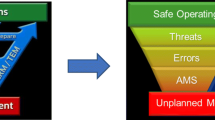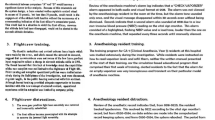Abstract
Human factors are the number-one reason for commercial jet planes to crash. Furthermore, of all possible human factors, communication is the number one offender [1–3]. Evidence suggests exactly the same for acute care medicine [4–12]. However, in contrast to aviation, medical curricula focus on factual knowledge and procedural dexterity but rarely address ingrained culture or its effect upon communication [4–11]. The airline industry felt compelled, as lives, and profits, were at stake [2]. With medical errors believed to cause almost 100,000 deaths annually in the USA, and representing the eight leading cause of preventable death [13–14], we ought to be similarly motivated. This chapter hopes to offer practical strategies so that our (verbal dexterity' can match our procedural dexterity. This will be done primarily by translating lessons from the flight deck to the bedside. After all, if other high-risk industries such as aviation can do so, then at least as much should be expected of acute care medicine.
“Meant is not said, Said is not heard, Heard is not understood, Understood is not done” [1]
Access this chapter
Tax calculation will be finalised at checkout
Purchases are for personal use only
Preview
Unable to display preview. Download preview PDF.
Similar content being viewed by others
References
Rall M, Dieckmann P (2005) Crisis resource management to improve patient safety. Euroanesthesia 2005. Available at: www.euroanesthesia.org/Education/~/media/Filesl…/17rc l.ashx. Accessed Dec 2009
Gladwell M (2008) The ethnic theory of plane crashes. In: Outliers. Little, Brown and Company, New York, pp 177–223.
The New York Times (October 1st, 2007) Fatal airline crashes drop 65 0/0. Available at: http://www.nytimes.com/200711010 I/businesslO Isafety.html. Accessed Dec 2009
Pronovost P, Berenholtz S, Dorman T, Lipsett PA, Simmonds T, Haraden C (2003) Improving communication in the ICU using daily goals. J Crit Care 18: 71–75
Sutcliffe K, Lewton E, Rosenthal M (2004) Communication failures: An insidious contributor to medical mishaps. Acad Med 79: 186–194
Gawande AA, Zinner MJ, Studdert DM, Brennan TA (2003) Analysis of errors reported by surgeons at three teaching hospitals. Surgery 133: 614–621
Knaus WA, Draper EA, Wagner DP, Zimmerman J (1986) An evaluation of outcomes from intensive care in major medical centers. Ann Intern Med 104: 410–418
Alvarez G, Coiera E (2006) Interdisciplinary communication: an uncharted source of medical error? J Crit Care 21: 236–242
Devita MA, Schafer J, Lutz J Dongilli T, Wang H (2004) Improving medical crisis team performance. Crit Care Med 32: S61–65
Gaba DM, Fish KJ, Howard SK (1994) Crisis Management in Anesthesiology. New York, Churchill Livingstone
Gaba DM (1992) Dynamic decision-making in anesthesiology: cognitive models and training approaches. In: Evans DA, Patel VI (eds) Advanced Models of Cognition for Medical Training and Practice. Sprinter-Verlag, Berlin, pp 123–147
St Pierre M, Hofinger G, Buerschaper C (2008) Crisis Management in Acute Care Settings: Human Factors and Team Psychology in a High Stakes Environment. Springer, New York
Kohn LT, Corrigan J, Donaldson MS (2000) To Err is Human: Building a Safer Health System. National Academy Press, Washington
Baker GR, Norton PG, Flintoft V, et al (2004) The Canadian Adverse Events study: the incidence of adverse events among hospital patients in Canada. Can Med Assoc J 170: 1678–1686
Royal College of Physicians and Surgeons of Canada (2008) CanMEDS framework. Available at http://rcpsc.medical.org/canmeds/index.php. Accessed Dec 2009
Davis D, O'Brien MA, Freemantle N, Wolf FM, Mazmanian P, Taylor-Vaisey A (1999) Impact of formal continuing medical education: Do conferences, workshops, rounds and other traditional education activities changes physician behavior or health care outcomes. JAMA 282: 867–874
Helmreich RL, Merritt A (2000) Culture in the cockpit: Do Hofstede’s dimensions replicate. J Cross-Culture Psych 31: 283–301
Helmreich RI (1994) Anatomy of a system accident: the crash of Avianca Flight 052. Int J Aviation Psych 4: 265–284
Sohn HM (1993) Intercultural communication in cognitive values: Americans and Koreans. Language and Linguistics 9: 93–136
Dunn E.J, Mills, P.D. Neily J, Crittenden MD, Carmack AL, Bagian JP (2007) Medical team training: Applying crew resource management in the Veterans Health Administration. It Comm J Qual Patient Saf 33: 317–325
Kim J, Neilipovitz D, Cardinal P, Chiu M, Clinch J (2006) A pilot study using high-fidelity simulation to formally evaluate performance in the resuscitation of critically ill patients: The University of Ottawa Critical Care Medicine, High-Fidelity Simulation, and Crisis Resource Management. Crit Care Med 34: 2167–2174
SBAR Institute for Healthcare Improvement (2009). SBAR technique for communication: a situational briefing model. Available at: http://www.ihi.org/IHI/Topics/PatientSafety/SafetyGenerallTools/ SBARTechniqueforCommunicationASituationalBriefingModel.htm. Accessed Dec 2009
Brindley PG (2007) Novel technique for critical care training. Can Med Assoc J 176: 68
Airbus Flight operations briefing notes (2009) Human performance: Managing interruptions and distractions. Available at: http://www.skybrary.aero/bookshelf/books/176.pdf. Accessed Dec 2009
Brindley PG, Hudson D, Lord JA (2008) The blindfolded learner: A simple intervention to improve crisis resource management skills. J Crit Care 23: 253–254
Aron D, Headrick L (2002) Educating physicians prepared to improve care and safety is no accident: it requires a systematic approach. Qual Saf Health Care 11: 168–173
Author information
Authors and Affiliations
Editor information
Editors and Affiliations
Rights and permissions
Copyright information
© 2010 Springer Science + Business Media Inc.
About this paper
Cite this paper
Brindley, P.G. (2010). Communication in Crisis: The Importance of ‘Verbal Dexterity’. In: Vincent, JL. (eds) Intensive Care Medicine. Springer, New York, NY. https://doi.org/10.1007/978-1-4419-5562-3_54
Download citation
DOI: https://doi.org/10.1007/978-1-4419-5562-3_54
Publisher Name: Springer, New York, NY
Print ISBN: 978-1-4419-5561-6
Online ISBN: 978-1-4419-5562-3
eBook Packages: MedicineMedicine (R0)




